Navigating Tobago’s Surprising Underwater Landscape
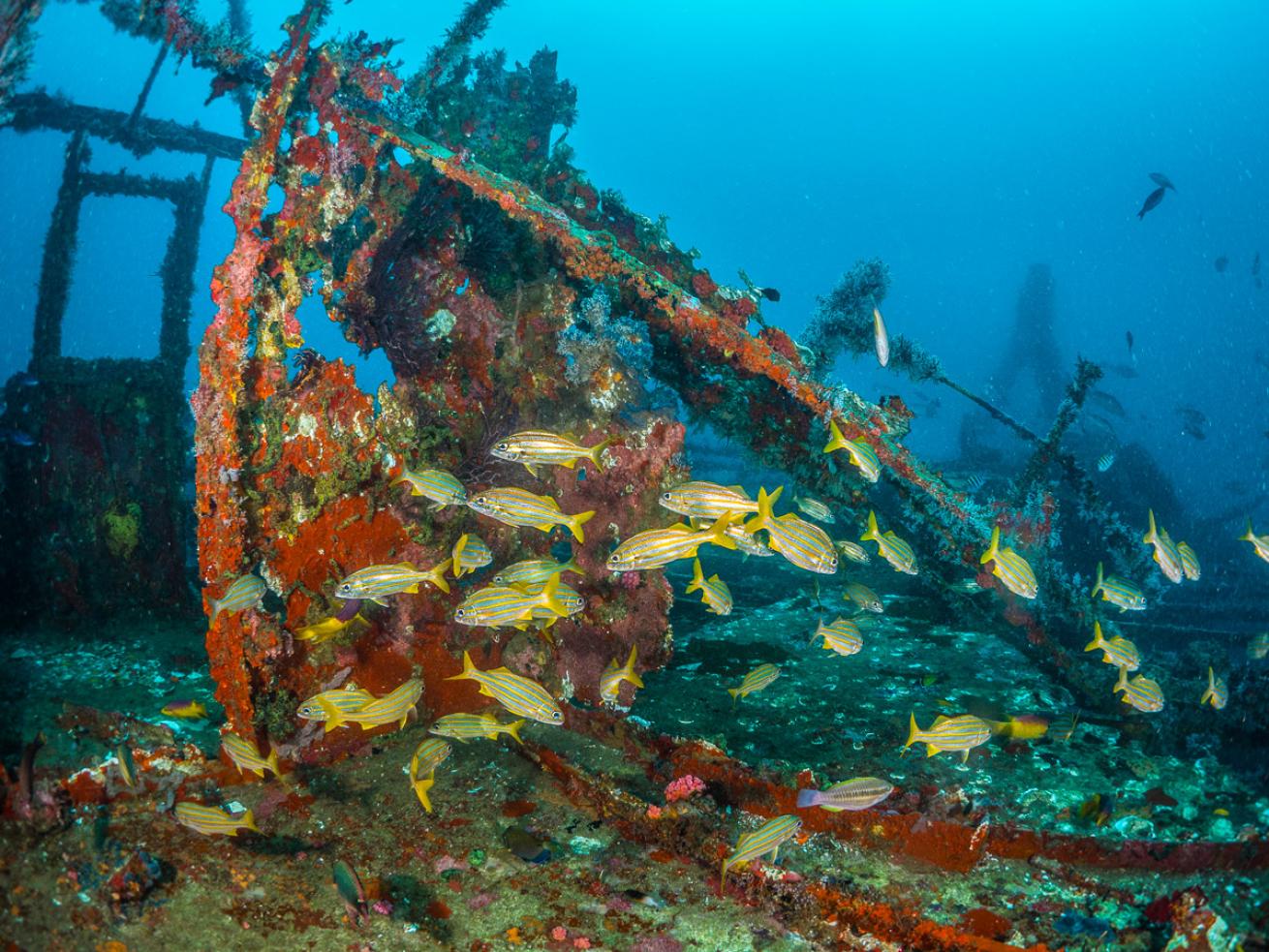
Kadu PinheiroThe purpose-sunk wreck of the Maverick, a 168-foot-long cargo ferry, stands out as a fish magnet on Tobago’s southern end.
The coastal road leading us north from the airport to Speyside, on Tobago’s northeast side, unspools like something serpentine and with a life all its own.
Immortelle trees dripping with curtains of bright-orange blooms and mango tree branches so laden with the golden fruit they appear to be offering it up to me on a platter compete for my attention with roadside stands piled with plantains, green coconuts and pumpkins.
The air itself is redolent.
Weary from the sterility of the three airports I’ve passed through since leaving Tampa to get here (including Trinidad, Tobago’s sister island, from which I caught a puddle jumper for the final 20-minute flight onward), I feel like I’ve been plunged straight into some kind of tropical video game.
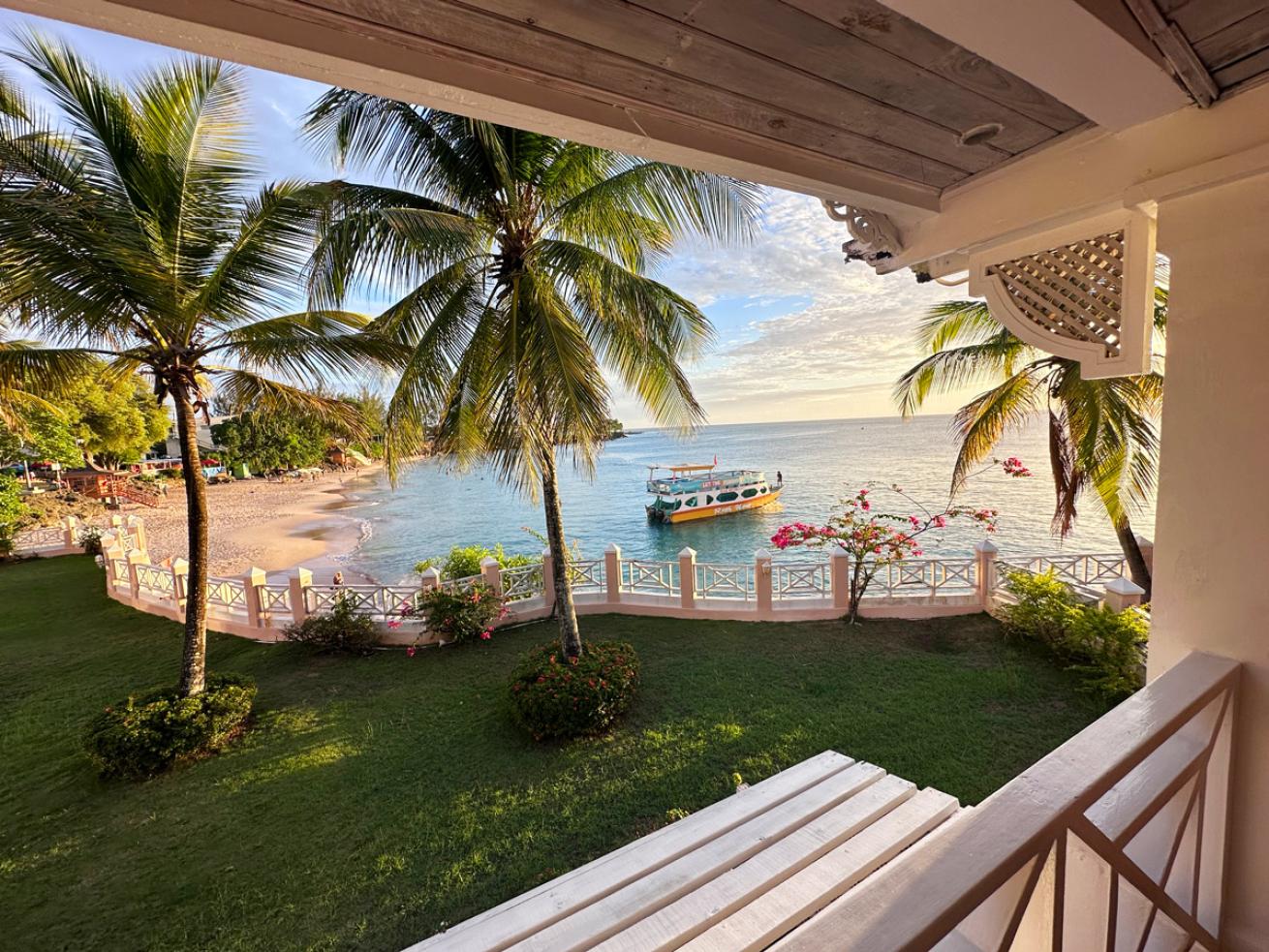
Terry WardThe view of Store Bay from Coco Reef Resort & Spa in Crown Point
My driver, Oswyn Kerr, is navigating the hairpin curves and potholes with the intuition of a Formula 1 driver while assuring me the island has only two speeds. “There’s only pause and stop in Tobago,” he tells me in a syrupy West Indian drawl that’s new to my ears.
But for me, it’s just go, go, go.
I’ve dived all over the Caribbean—from the shore-diving paradise of Bonaire and the drifts of Cozumel to the colorful walls of Grand Cayman.
But Tobago, a 116-square-mile island just off the coast of Venezuela that’s the beachy playground for its industrialized neighbor, Trinidad, had somehow always eluded me while remaining top of mind. Diver friends had so often waxed lyrical about what a world apart it was in the Caribbean.
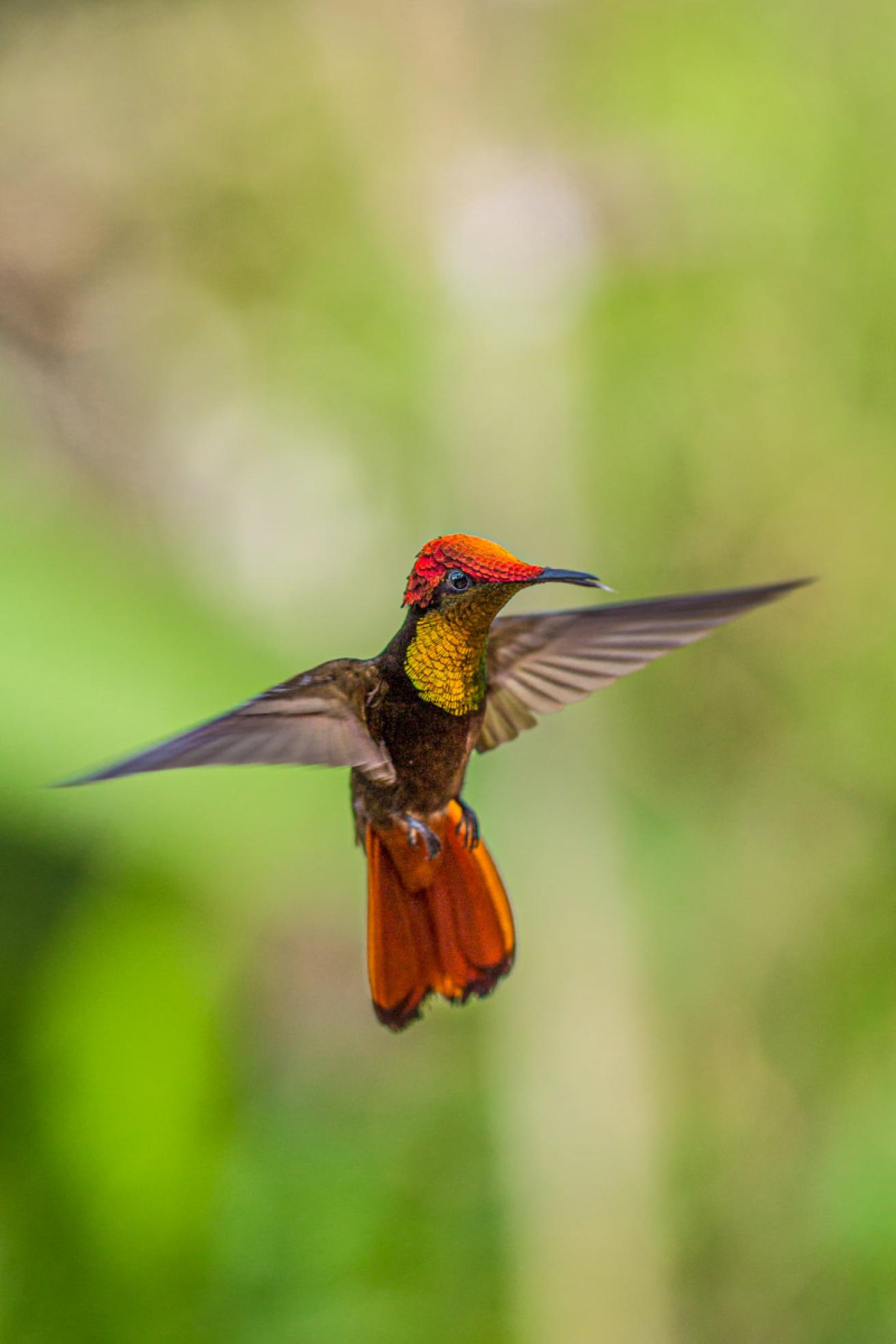
Allison Vitsky SallmonTobago is home to six hummingbird species
How it took me almost 30 years since getting certified to make my way here, however, is beside the point. I’d finally made it to Tobago, and I had five days to see what I’d been missing. I’d come to maximize.
I roll up in Speyside in time to catch the day’s dive banter over a rum punch and delicious dinner of lionfish ceviche and grilled tuna at a restaurant down the street from Tobago Dive Experience. Giddy chatter rises from a table full of teens and preteens and a few of their parents who are on a weekend trip from Port of Spain in Trinidad to finish their PADI Open Water Diver courses.
We’re eating the lionfish they’ve speared and learned to clean that day with their instructors, and the kids—hailing from Trinidad, Texas and Canada—are chatting excitedly about a manta they saw circling the jetty when the boat returned from the afternoon dives.
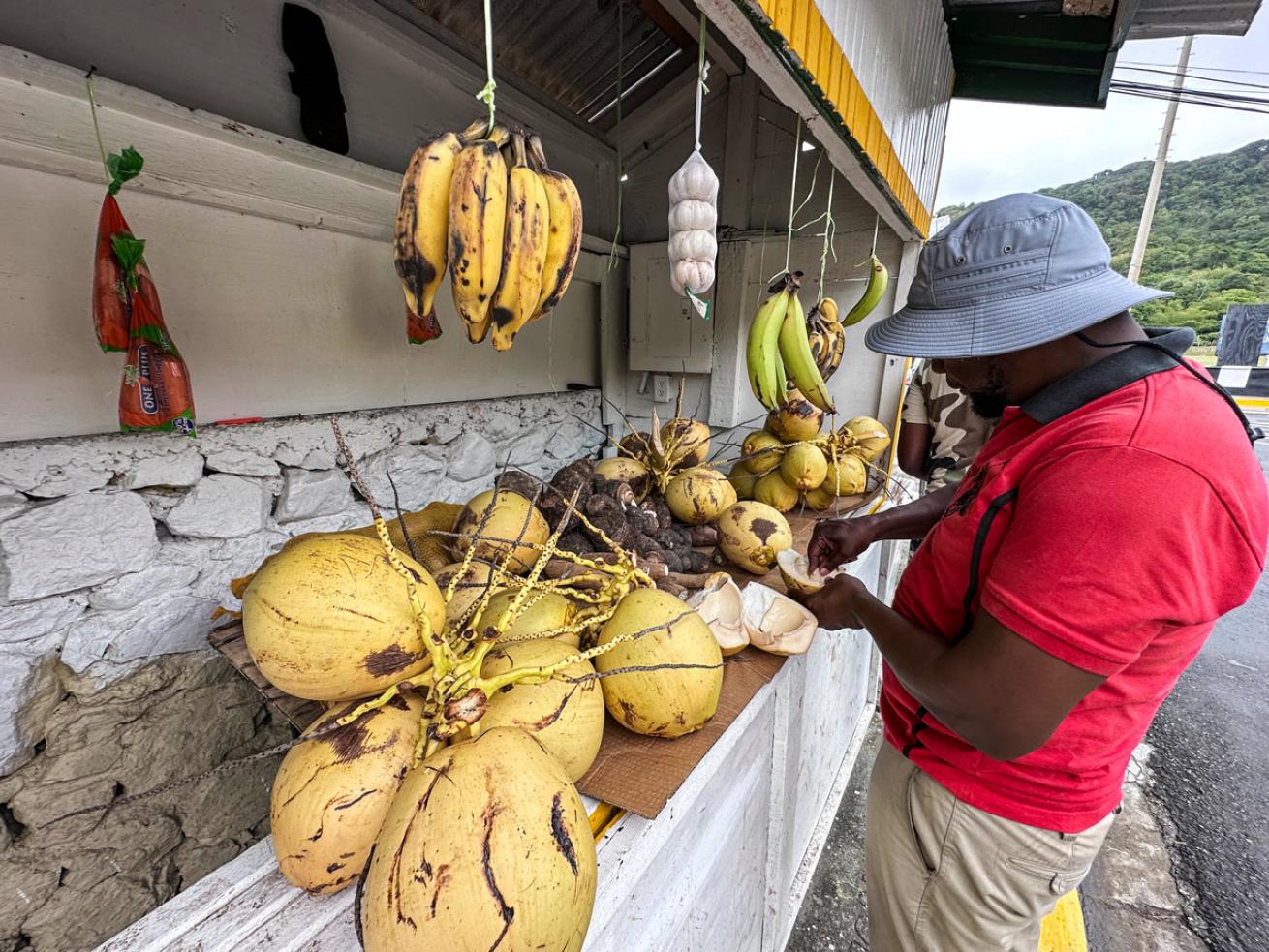
Terry WardDriver Oswyn Kerr digs in at a roadside stall in Speyside.
Mackenzie, a teenager from Ontario who’s about to be a senior in high school, tells me she used to think she wanted to study medicine at university. “But after learning to dive, I think I want to find a job related to ocean conservation and marine biology,” she says.
This is exactly the level of stoke I’ve come to Tobago hoping to encounter, and I can’t wait to crash for the night just to wake up and see what the next day’s diving in Speyside has in store.
This is exactly the level of stoke I’ve come to Tobago hoping to encounter, and I can’t wait to crash for the night just to wake up and see what the next day’s diving in Speyside has in store.
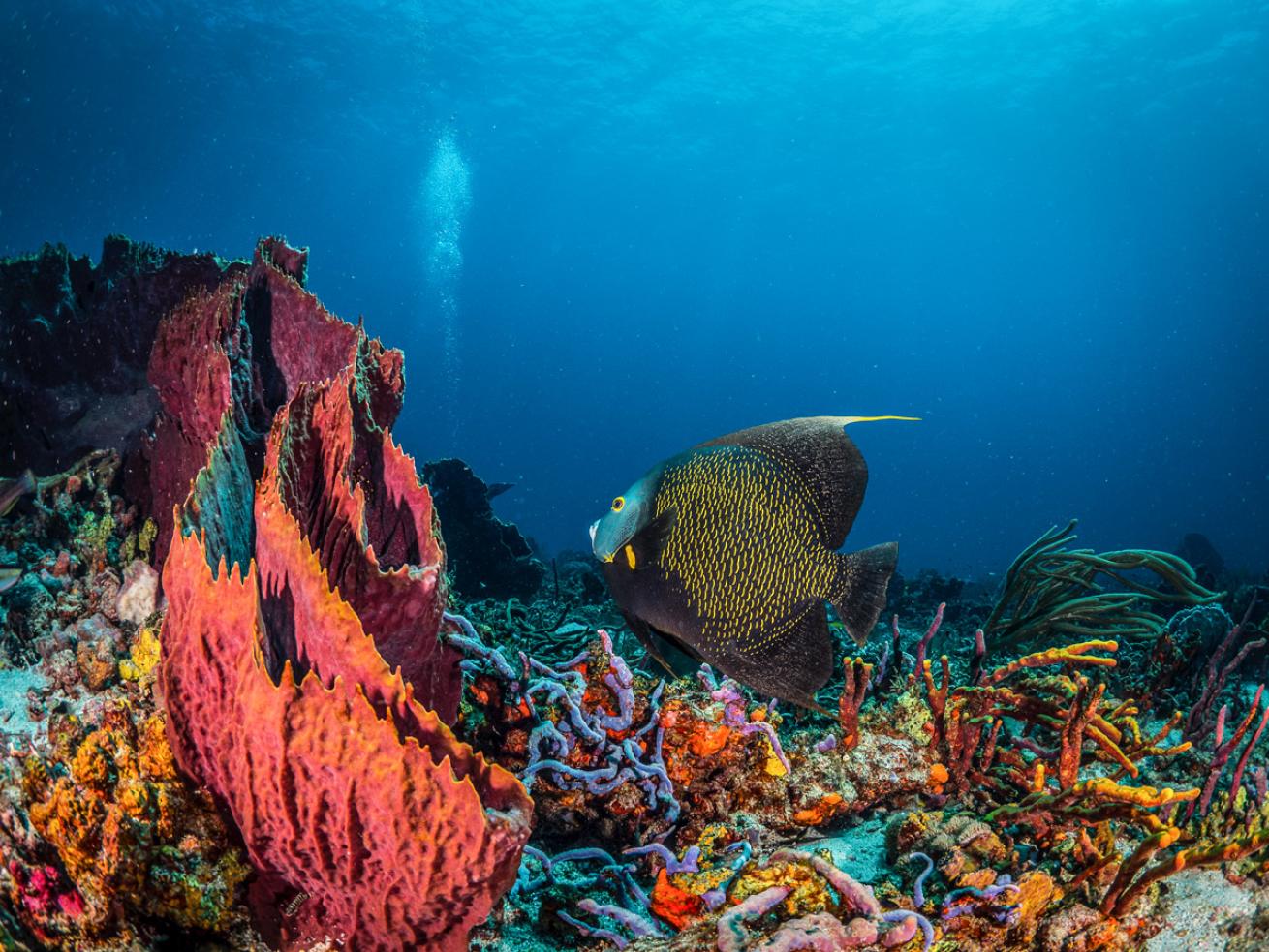
Kadu PinheiroA French angelfish (Pomacanthus paru) at Japanese Gardens in Speyside, a standout among Tobago’s northern dive sites.
Rare Underwater Scenery
“Everyone wants to see mantas, but the flameback and cherub angelfish—that stuff is rare,” Sean Robinson, of Tobago Dive Experience, tells me, thumbing through a fish ID book outside the dive shop to show me the tiny neon-blue- and-yellow-hued angelfish species that in-the-know divers thrill to lay eyes on, much in the way passionate birders travel to add rare species to their list.
Many of his diver clients are bird-obsessed too, Robinson says as an aside—and Tobago delivers there as well, with one of the highest densities of bird species in the world, including six species of hummingbird alone (several of them are hovering nearby at feeders hung outside of Robinson’s home, and I keep getting distracted by their beauty).
I’m here to dive though, and from the dock in Speyside we can choose from 40 different sites within a 10-minute boat ride, Robinson tells me (another diver who’s been here a few days already mentioned that diving here felt like being on a liveaboard on land).
So we’re already zipping up our wetsuits and preparing to buckle into our BCDs as the dive boat speeds away from the dock to reach our first site of the day, Black Jack Hole, just offshore from Little Tobago Island and named for the black trevally that cloud the waters from May to July.
I back-roll off the boat into at least 100 feet of viz and a wall deluged with lilac-hued creole wrasse and fluttering black triggerfish. As we drop to the reef, schools of grunts, spadefish and southern sennet rush about like high school cliques teeming the great ocean hallway. Colorful fairy basslets sprinkled across the reef sparkle like groupies trying to get their attention.

Allison Vitsky SallmonReefs in Speyside boast huge sponges twisted into odd shapes from the constant currents
The wide-angle views mobbed with fish from top to bottom instantly remind me of some of the fishiest dives I’ve done in the Pacific and then Tobago’s legendary supersize sponges come into view and I’m reminded of exactly where I am.
Currents from South America’s Orinoco River flowing north into the Caribbean Sea wash Tobago’s coastline with nutrient-rich waters that feed barrel and vase sponges growing so gapingly grand I feel tempted to curl up inside them for a nap. I’ve never seen sponges this big and bountiful in Caribbean waters, and I let gravity pull my tank under me to do a slow 360-degree roll that lets me take in the whole scene in one fell swoop.
Our second dive, Bookends, is named for two rocky columns rising from the seabed. We’ve barely been down a minute when I hear Robinson tapping his cylinder to draw my attention to a pebbly area near the reef, where a jewel-toned flame- back angelfish is eyeing us reticently as if to say, “Hey, lady. It’s not all about the wide-angle view here.”
As much as I love the sight of the little critter, my heart really gets racing when we drop over a ridge and fin down into a sandy bowl, the sea churning like a washing machine overhead. Above us, enormous torpedo-like tarpon patrol the scene—I take a breath in and let my body float gently up a foot or two, the nearer to come to the stealthy fish, but they recoil in equal measure with their own perfect buoyancy and at the precise moment of my advances.
The next day’s dives are equally exuberant.
“It looks more like a yurt than an underwater living structure,” says Mike Brennan, Robinson’s partner at Tobago Dive Experience, referring to the island’s most famous underwater formation and a celebrity among corals.
Related Reading: Dive Hotspots: Saba, Malta and Loreto
We’re getting ready to dive the site Coral Gardens, home to the largest brain coral in the world, which has been thriving in about 55 feet of water for more than 400 years. It makes for an epic underwater photo when divers superman over its impressive expanse, stretching some 16 feet across. But I’m just as smitten by the oceanic triggerfish hovering around the brain coral and the whole aquarium effectit anchors, with thousands of brown chromis crowding the scene.
Japanese Gardens, our next dive site, proves to be the real scene stealer, however, and is breathtaking from the drop. The sloping reef on the south side of Goat Island plays out like a jaunt through an underwater amusement park where yellow tube sponges, waving purple fans and endless barrel and vase sponges are the carnival rides and hundreds of black durgons, chromis and grunts are there for our amusement.
About halfway through the dive, we dump the air from our BCDs and stay low to shoot through Kamikaze Cut, where the water gets squeezed through two pinnacles. Jacks patrol the upper part of the reef in their perpetual on-a-mission manner as the area nicknamed Bonsai Forest comes into view, with a white sandy bottom and waving soft corals sprouting up everywhere like cattails doing a wispy dance in the current. It’s the kind of dive you almost have to recover from when you surface because the beauty is so much sensory overload.
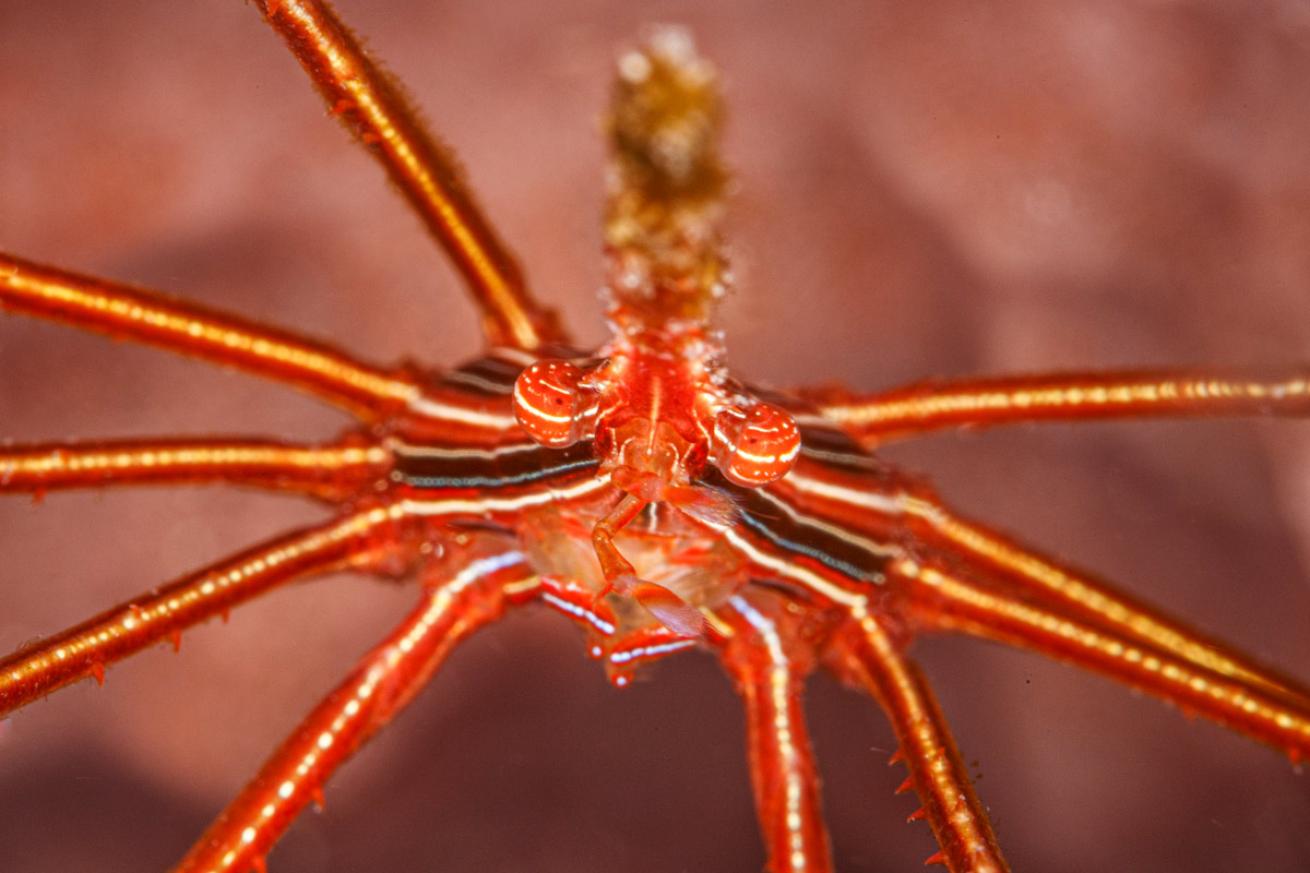
Allison Vitsky SallmonA colorful arrow crab at macro hotspot Mount Irvine Wall in Crown Point.
I’m in for more of Tobago’s supermodel looks later during a birding tour to Little Tobago Island, less than 2 miles off Speyside’s coast, with Zolani Frank, who grew up exploring his homeland’s wild hinterlands. Macro wonders on land come in the form of the lairs of trapdoor spiders Frank points out along the trail, directing my eyes to the perfectly circular “doors” the spiders build into mud banks—he pushes an ingeniously engineered insect-made hinge on the door to show me how it opens to snare passing prey, much to my wonder.
We climb a short way up to reach the island’s windward side, where pelagic seabirds, including the Caribbean’s most important population of red-billed tropicbirds, with their long, elegant tail feathers, arrive to nest. They coast on the thermals, reminding me of sharks patrolling the opening of an atoll, waiting for the ideal moment to crash land near their nests in the cliffs to feed their young.
We’ve barely been down a minute when I hear Robinson tapping his cylinder to draw my attention to a pebbly area near the reef, where a jewel-toned flameback angelfish is eyeing us as if to say, “Hey, lady. It’s not all about the wide-angle view here.”
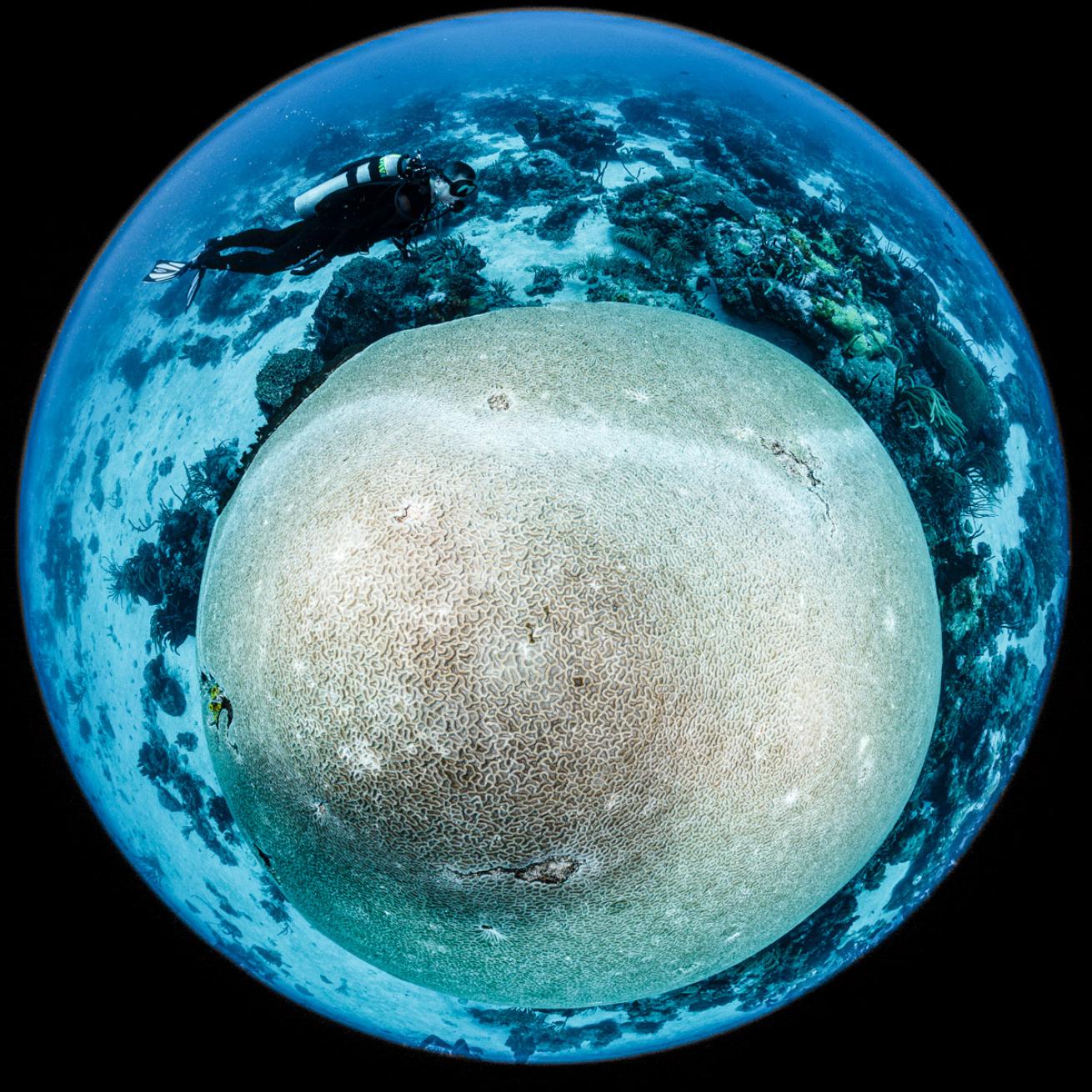
Allison Vitsky SallmonA diver admires the world’s largest known brain coral near Little Tobago Island.
A Night Dive To Remember
Before I leave Speyside for the southern reaches of the island, I decide to do something I usually pass on these days, when a hot shower and sundowners tend to take preference over shimmying into a wetsuit at sunset.
I gear up for a night dive.
Brennan tells me the site Goat Island Dream gets a rebrand after dark, when it becomes Turtle Reef. As soon as we drop down, I see why.
A massive hawksbill turtle has wedged its beak under the overhang of a towering sponge and is settled in for a rest, as snug as a bug in a rug. It’s the first of several turtles in repose we see over the course of a half hour underwater in the dark. “Slow is fast when it comes to night diving,” Brennan had reminded me just before we headed under, and on this dive it feels like all the wonders find me.
A tiny Caribbean reef squid divebombs my torch then lets out a wispy trail of black ink, having startled itself, and I watch as one sculptured slipper lobster after another scurries out from under a coral head.
In the sandy expanse surrounding us, thousands of tiny reflections catch my torch’s beam—they’re the eyes of countless red night shrimp cartwheeling across the seabed as if they’re as high on the ocean as I am right now.
When we surface, a British diver with hundreds of logged dives—but before now, never a night dive—sums it up perfectly. “I can’t believe all I’ve been missing,” he says, as soon as he pulls the reg from his mouth.
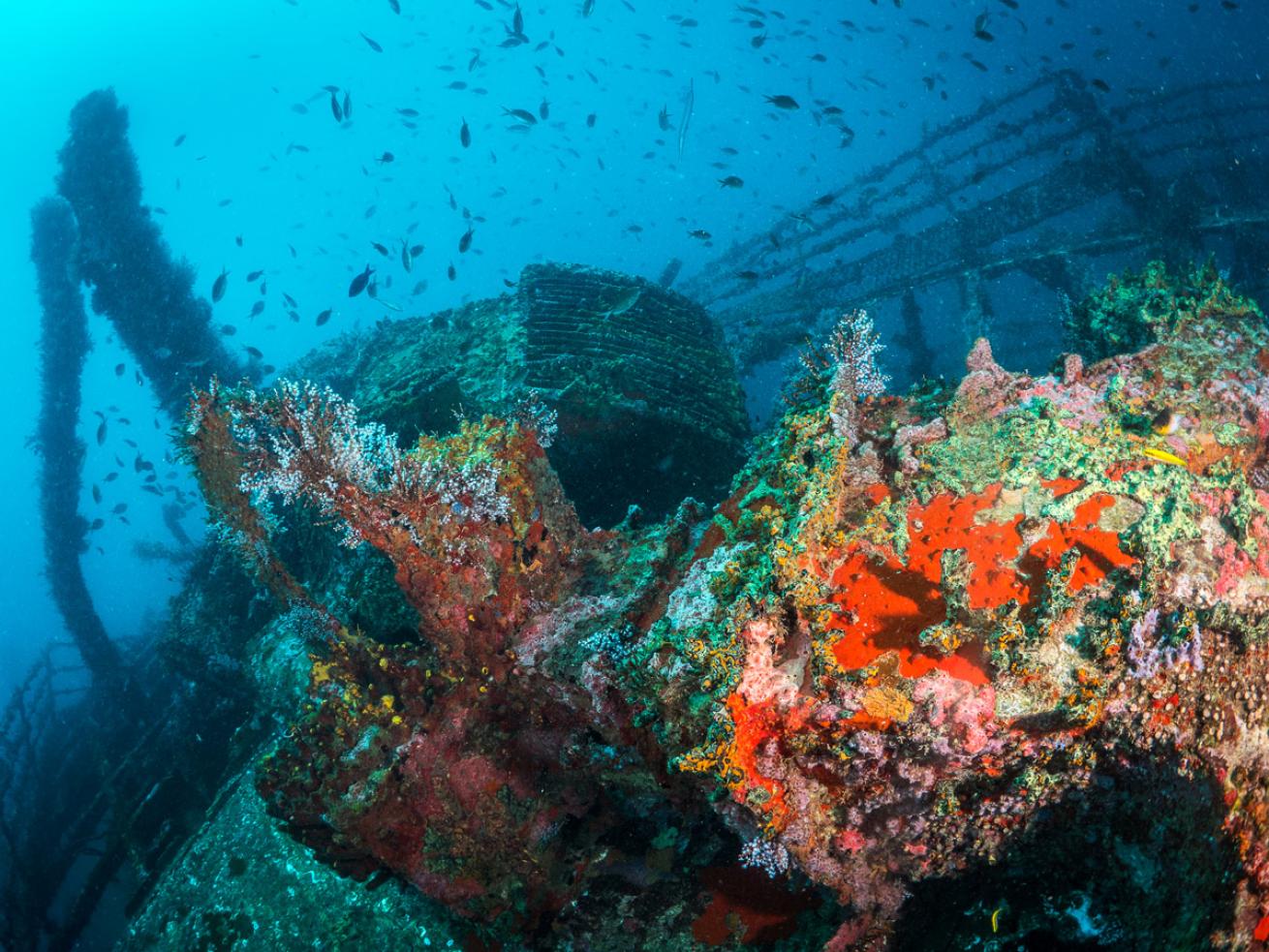
Kadu PinheiroMarine life proliferates on the wreck of the Maverick on Tobago’s southern side.
South For a Sweet Finish
Tobago’s northern dive sites around Speyside, with better visibility and bigger sponge life, tend to steal the spotlight from the island’s south. But I always go to new dive destinations looking for a complete picture of the scene, both in the water and out. So I’m excited to book three dives in Tobago’s southern reaches in Crown Point, just minutes from the airport, with Undersea Tobago.
On our drive south, sensing my need to taste all the island offers, Kerr pulls over at a roadside stand where an older couple are slapping together “doubles” from fixings tucked inside a cooler. The delicious Trinidadian street food with Indian roots is made from a flatbread called barra and filled with spicy chickpea-laded channa and costs about a $1.50 a pop. We wash the doubles down with fresh coconut water, deftly macheted open in split seconds before our eyes. Kerr drops me off, suitably fortified for more underwater exploring, at Coco Reef Resort & Spa just in time for a perfectly timed dive with Derek Chung of Undersea Tobago.
We enter the boat right from the palmfringed private beach fronting the resort and his shop and zip out to a site called Diver’s Thirst, about a mile offshore. It’s best dived at low tide, since the surface currents can crank outside of that window, Chung tells me, appearing just as stoked as I am that our timing is on point.
“The northwest part of Tobago, without a doubt, has the best coral reefs on the island. But what’s good diving? It’s all subjective,” Chung says as we gear up. It’s a concept I understand inherently as an experienced diver always on the lookout for something I haven’t seen before, whatever it may be.
Related Reading: Dive Travel Now: A Look at Panama, St. Lucia and Vancouver Island
Trinidad’s shoreline shimmers on the horizon due south of us, and frigate birds, the pirates of the sea, cloud the near distance as we back-roll into the water. The underwater landscape is a patchwork of rocky ledges and sandy canyons cut through with coral that shimmers in the equatorial sun. Under one ledge, we spot something I’ve never seen on more than 500 dives—a large reef shark sleeping where I’d ordinarily expect to encounter the usual mellow nurse shark lazing. It appears as surprised as we are, spooks and gives three powerful thrashes of its tail, disappearing over the reef in a flash. When we surface, Chung tells me it’s only the second time he’s seen a sleeping reef shark.
The next day, the wreck of the Maverick, a 168-foot-long former cargo ferry sunk in 100 feet of water as an artificial reef, makes up for what Tobago’s southern waters lack in dazzling visibility with easy swim-throughs and fish galore.
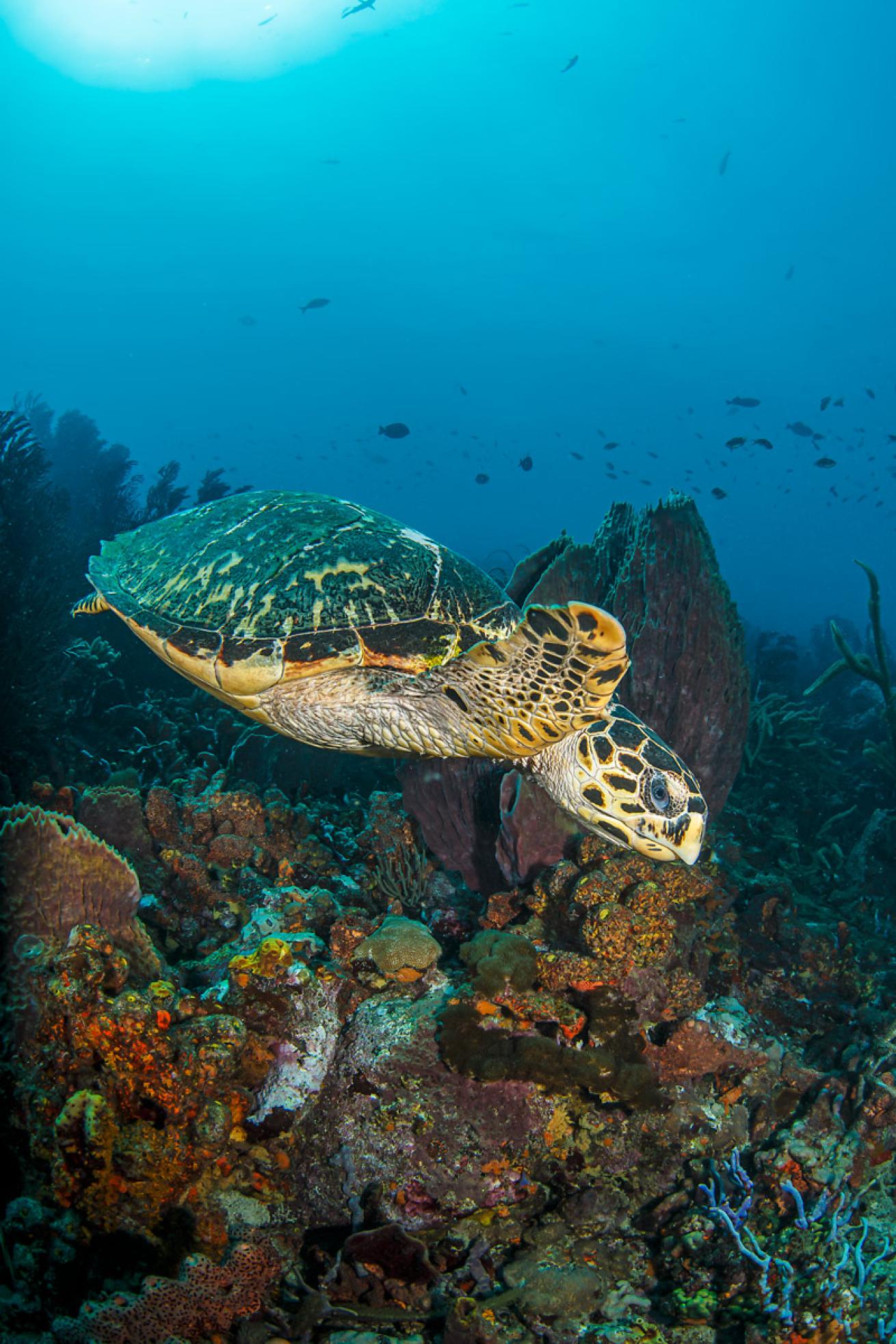
Allison Vitsky SallmonA hawksbill turtle passes through the dive site Coral Gardens.
Sunken for more than half a century, the wreck’s hulking skeleton acts as a marine life magnet on the otherwise barren seafloor, and bonito, amberjack and creole wrasse are showering the superstructure with their appreciation. Chung and I do a fun line-of-sight penetration through the car deck and exit out the ship’s forward loading hatch before enjoying a surface interval on a beautiful beach that may soon be developed into the front yard of a big-name luxury hotel, according to the island scuttlebutt. For now, at least, it’s crisscrossed with the tracks of nesting sea turtles and not a soul in sight.
Our last dive is just around the corner, at Mount Irvine Wall, a colorful rocky reef teeming with macro life I’d not expected to find in Tobago.
Here a shortnose batfish, there a seahorse and free-swimming octopus. Candy cane shrimp and arrow crabs venture out from every possible sponge and nook and cranny. Under a ledge packed with more spiny lobsters than I can count, glassy-eyed sweepers are moving to and fro in a confusing and confused panic at the mere sight of me.
“We don’t enjoy reliably crystal-clear waters here like our northern neighbors do in the Caribbean,” Chung tells me later, as I’m typing away at notes on my phone, trying to formulate the story that will tie my adventures in Tobago together. “But sometimes clear water just means you can clearly see there’s nothing.”
In Tobago, I learned that as long as you are looking—whether stopped, paused orin go, go, go dive mode—there is always something surprising to admire.
Need To Know
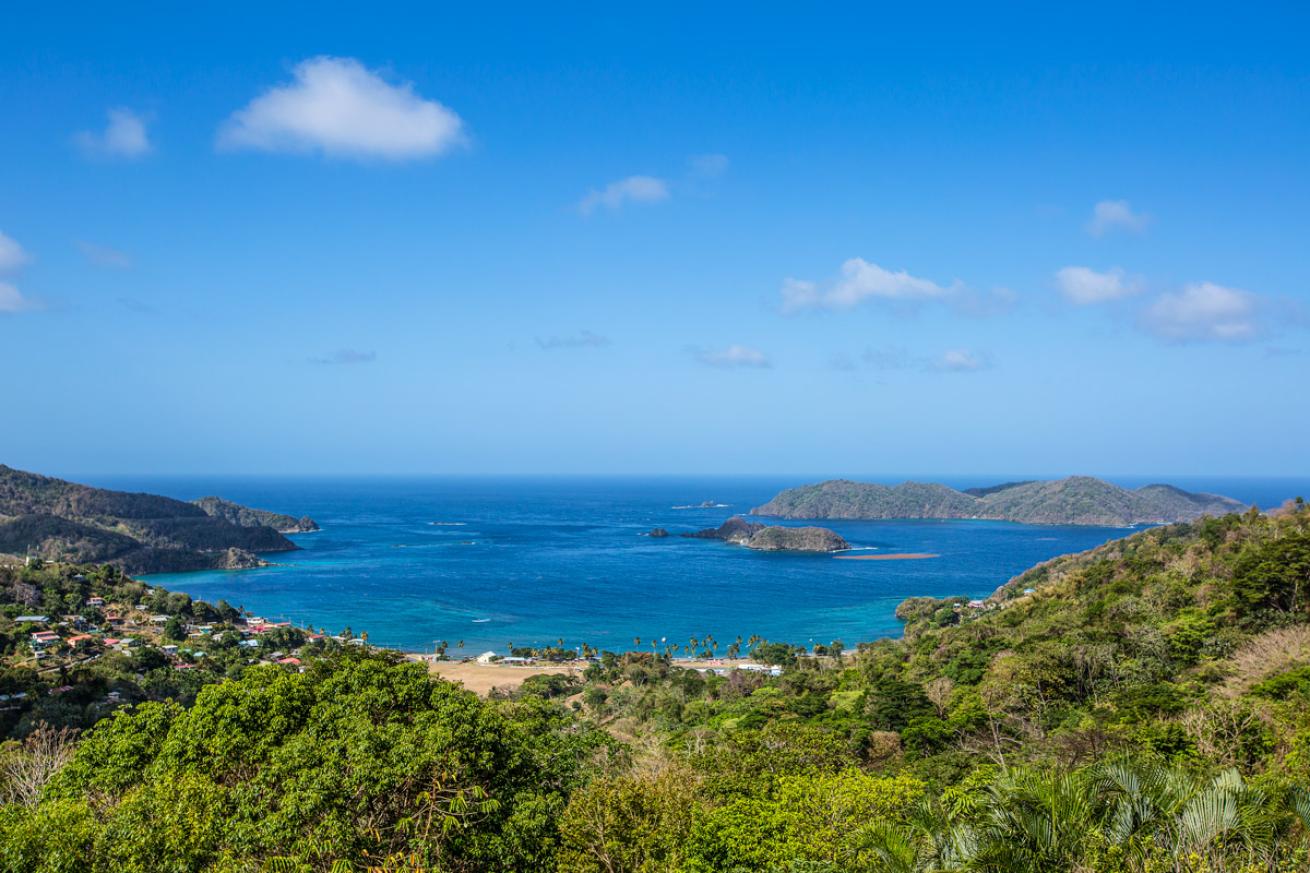
Allison Vitsky SallmonAn aerial view of Batteaux-Bay.
When To Go
Located below the hurricane belt, Tobago beckons with great diving year-round. Visibility is generally best between January and June. June to November ushers in rainier conditions and the potential for runoff from the Orinoco River, which can impact visibility. Humpback whale sightings are common in Tobago’s waters from late January into May, but rarely experienced while diving.
Dive Conditions
Water temperatures consistently hover around 80 degrees, with typical visibility around 80 feet at the northern dive sites and 60 feet in the south.
Operators
Tobago Dive Experience (tobago diveexperience.com); Undersea Tobago (underseatobago.com)
Where To Stay
North: Attached to Tobago Dive Experience in Speyside, Manta Suites at Tobago Dive Experience has multibedroom apartments with full kitchens and outdoor showers overlooking Tyrrel’s Bay, Goat Island and Little Tobago Island. You’re steps from the dive shop and a short pickup truck ride to the dock to meet the dive boat.
South: In Crown Point, Coco Reef Resort & Spa is Tobago’s grande dame hotel. It overlooks a private white-sand beach and the onsite dive shop at Undersea Tobago, which uses the hotel’s sheltered lagoon for beginner courses and launches boat dives right from the palm-lined beach. The hotel’s Sunset Villa oncehosted Elton John and is ideal for traveling families or honeymooners.
Topside Must-Sees
It’s tempting to stay underwater most of the time in Tobago, but this is an island where you won’t want tomiss the spectacular topside views and adventures.
Paddle Through Bioluminescence
After-dark kayak tours with Radical Sports Tobago from Pigeon Point into the sheltered mangrove wetlands of Bon Accord Lagoon on Tobago’s southwest coast come with a light show in the form of dazzling bioluminescence.
Go Birding On Little Tobago Island
Tobago-born Zolani Frank, who knows his island’s natural attractions inside-out, leads birding tours to Little Tobago Island, where you can see elegant red-billed tropicbirds, Audubon’s shearwaters and other pelagic sea- birds that come to nest on the plunging cliffs.
Visit The World's Oldest Legally Protected Forest Reserve
Established in 1776, Tobago’s backbone is the Tobago Main Ridge Forest Reserve, a UNESCO bio- sphere reserve and tropical rain-forest home to rare and endemic species including the whitetailed sabrewing hummingbird and ocellated gecko.










